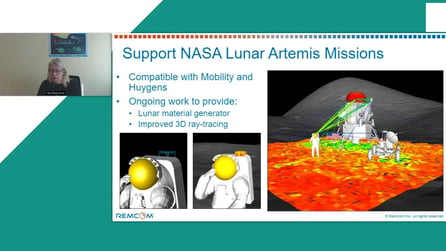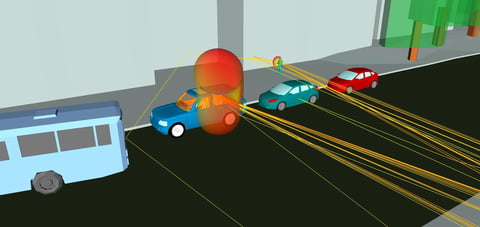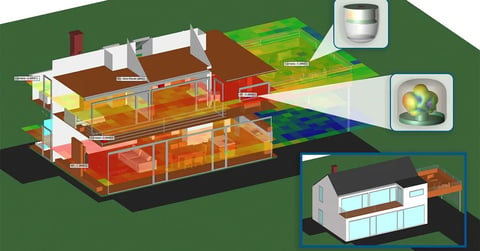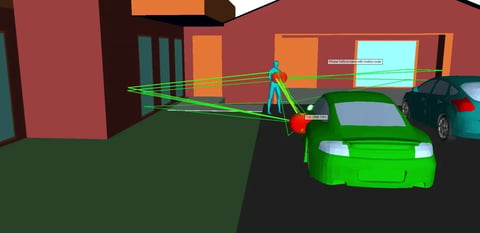- Applications
- Wireless Propagation
Wireless Propagation Simulation Software
Remcom offers simulation software and consulting services for wireless applications, including indoor and outdoor coverage for 5G, 6G, and WiFi, dynamic wireless mobility scenarios, and complex industrial environments.
Our Wireless InSite software provides efficient and accurate predictions of radio wave propagation and communication channel characteristics in complex urban, indoor, rural, and mixed path environments. Through accelerated 3D ray-tracing, our products help customers assess performance of RF systems in wireless scenarios, simulating multipath and fading effects to fully characterize propagation channels.

Remcom wireless simulation provides valuable insight for dynamic scenarios, including:
- 5G MIMO beamforming and spatial multiplexing
- Multipath and fading for comms to mobile pedestrians, vehicles, or aircraft
- V2V, V2X, and in-car/inflight WiFi
- Ad-hoc and temporary networks
- Indoor WiFi coverage and MIMO analysis
- Microcell and macrocell coverage
- 5G NR, WiFi n/ac/ax, and LTE throughput
Wireless InSite’s unique collection of features empowers users to analyze a variety of challenges in the rapidly-evolving field of wireless communications. Here are a few examples:
Suburban mmWave and sub-6 GHz propagation modeling:
-
3D deterministic simulation using advanced ray tracing techniques
-
Surface materials impact reflection and transmission coefficients
-
MIMO channel matrix captured to perform SU-MIMO and MU-MIMO beamforming
-
Outputs include RSSI, LTE, 5G NR capacity and throughput









-
Blockage and impact of factory workers accounted for using advanced SBR techniques
-
Determine ideal placement of Access Points in a very cluttered environment
-
Tracking of workers and movement of specialized vehicles like forklifts
-
5G NR coverage analysis on different factory floors
RF Communications-Based Train Control (RF-CBTC):
-
Model RF-CBTC channel and effects of multipath inside tunnels
-
3D deterministic simulation accounts for position and impact of surrounding clutter
-
Signals are predicted using SBR techniques including propagation inside train car
-
Account for blockage from passengers and interference from access points
-
Include effects of arriving or departing train from station on RSSI for WiFi, LTE and 5G NR
.png)
Additional Information
-

Webinars
Model And Simulate Dynamic RF Scenarios Using Time-Based Mobility
Tune in to see an in-depth look at modeling dynamic RF environments with Wireless InSite, a powerful wireless prediction and simulation platform. Viewers will learn how to simulate the movement of transceivers, antennas, and objects within user-defined scenes, supporting applications ranging from terrestrial communication systems to lunar missions.
Explore Resource
Webinars
Time-Based Mobility of RF Systems in Wireless InSite Release 4.0
Learn about the next generation of Wireless InSite, featuring a robust mobility framework that accurately models the movement of transceivers and objects within a user-defined scene.
Explore Resource
Webinars
Smart Home Device Design and WiFi Connectivity Using EM Simulation
This webinar demonstrates the strengths of Remcom’s XFdtd and Wireless InSite for designing and simulating smart home devices, analyzing propagation and beamforming capabilities, and assessing throughput performance of the devices via MIMO techniques.
Explore Resource -

Application Examples
Throughput of a 5G New Radio FD-MIMO System in an Urban Area Using Custom Beamforming
This example demonstrates how a custom beamforming table can be used to model downlink data rates from three MIMO base stations for 5G New Radio in a section of Boston.
Explore Resource
Application Examples
Maximum Permissible Exposure Analysis in an Urban Environment
Wireless InSite can model Maximum Permissible Exposure (MPE) to determine if there is a hazard to personnel from a particular high-power EM source. This output is displayed as color coded hazard zones within the GUI of Wireless InSite.
Explore Resource
Application Examples
Overcoming Unknown Layout Limitations when Modeling Outdoor-to-Indoor Propagation
Wireless InSite has a hybrid method that combines the full 3D ray tracing model (X3D) with an empirical model called COST 231 to handle uncertainty with the interior layout of a floor plan. This example demonstrates setting up a typical scenario using the hybrid method.
Explore Resource -

Videos
Utilizing Electromagnetic Simulation Software
This brief interview with Remcom's engineers highlights the evolution of a software platform that unites Remcom's FDTD code with its ray-tracing tools to analyze complex near-field in large-scale propagation environments.
Explore Resource
Videos
Simulate Dynamic Wireless Mobility with Wireless InSite
This video demonstrates Wireless InSite's mobility features, including vehicle in-cabin radar coverage and ultra-wideband (UWB) visualization, child presence detection, moving platforms with velocities and time-based motion, and lunar RF systems simulations.
Explore Resource
Videos
Talking on the Moon: How Spectrum Research Will Shape the Next Era of Space Exploration
Greg Skidmore, from Remcom, attended a virtual workshop held by NTIA on November 6, 2024, focused on the challenges of developing this model, with discussions led by experts from various organizations highlighting obstacles such as the Moon's terrain and lack of gravity. The event aimed to enhance understanding and collaboration in this critical research area to support future lunar missions.
Explore Resource -

Publications
Breaking Boundaries in Wireless Communication: Simulating Animated, On-Body RF Propagation
This paper discusses how RF propagation simulations empower engineers in the design and development of wireless devices for body-worn applications.
Explore Resource
Publications
How LunaNet Will Bring Internet-Like Capabilities To The Moon
In this article, John Oncea explains NASA's LunaNet project and how Remcom's participation will help to ensure reliable network performance on the Moon. LunaNet will empower NASA to explore the Moon and lay the foundation to support missions to Mars and beyond in the future.
Explore Resource
Publications
Ray-Optical Modeling of Wireless Coverage Enhancement using Engineered Electromagnetic Surfaces: Experimental Verification at 28 GHz
In this paper, results are presented of propagation experiments conducted to verify the accuracy of a novel ray-optical scattering model for EES.
Explore Resource
Save time and reduce costs.
Contact Remcom today for a customized solution to your most complex electromagnetic challenges.
Request a Quote